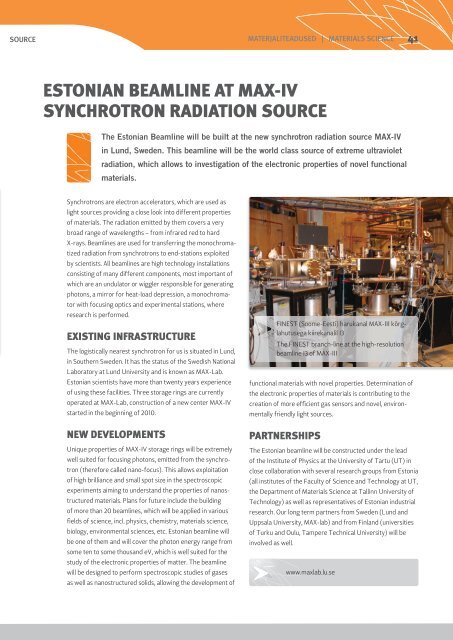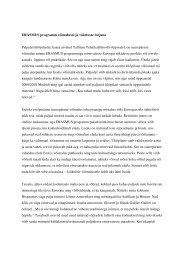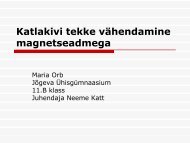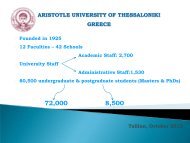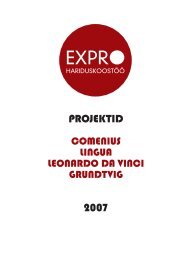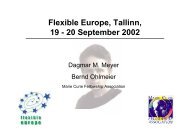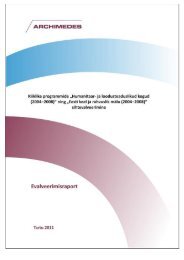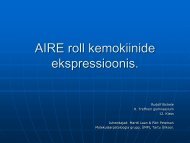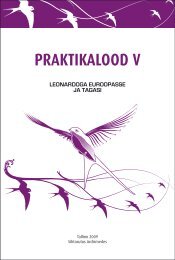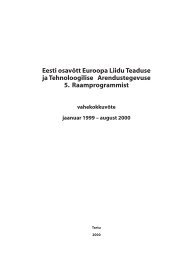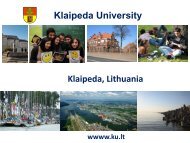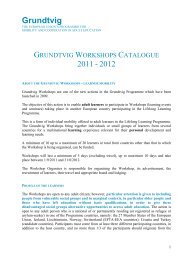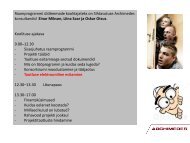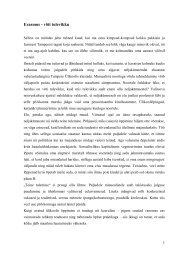Eesti teaduse infrastruktuuride teekaart - ETIS
Eesti teaduse infrastruktuuride teekaart - ETIS
Eesti teaduse infrastruktuuride teekaart - ETIS
- No tags were found...
You also want an ePaper? Increase the reach of your titles
YUMPU automatically turns print PDFs into web optimized ePapers that Google loves.
SOURCE MATERJALITEADUSED | MATERIALS SCIENCE 41ESTONIAN BEAMLINE AT MAX-IVSYNCHROTRON RADIATION SOURCEThe Estonian Beamline will be built at the new synchrotron radiation source MAX-IVin Lund, Sweden. This beamline will be the world class source of extreme ultravioletradiation, which allows to investigation of the electronic properties of novel functionalmaterials.Synchrotrons are electron accelerators, which are used aslight sources providing a close look into different propertiesof materials. The radiation emitted by them covers a verybroad range of wavelengths – from infrared red to hardX-rays. Beamlines are used for transferring the monochromatizedradiation from synchrotrons to end-stations exploitedby scientists. All beamlines are high technology installationsconsisting of many different components, most important ofwhich are an undulator or wiggler responsible for generatingphotons, a mirror for heat-load depression, a monochromatorwith focusing optics and experimental stations, whereresearch is performed.EXISTING INFRASTRUCTUREThe logistically nearest synchrotron for us is situated in Lund,in Southern Sweden. It has the status of the Swedish NationalLaboratory at Lund University and is known as MAX-Lab.Estonian scientists have more than twenty years experienceof using these facilities. Three storage rings are currentlyoperated at MAX-Lab, construction of a new center MAX-IVstarted in the beginning of 2010.NEW DEVELOPMENTSUnique properties of MAX-IV storage rings will be extremelywell suited for focusing photons, emitted from the synchrotron(therefore called nano-focus). This allows exploitationof high brilliance and small spot size in the spectroscopicexperiments aiming to understand the properties of nanostructuredmaterials. Plans for future include the buildingof more than 20 beamlines, which will be applied in variousfields of science, incl. physics, chemistry, materials science,biology, environmental sciences, etc. Estonian beamline willbe one of them and will cover the photon energy range fromsome ten to some thousand eV, which is well suited for thestudy of the electronic properties of matter. The beamlinewill be designed to perform spectroscopic studies of gasesas well as nanostructured solids, allowing the development ofFINEST (Soome-<strong>Eesti</strong>) harukanal MAX-III kõrglahutusegakiirekanalil I3The FINEST branch-line at the high-resolutionbeamline I3 of MAX-IIIfunctional materials with novel properties. Determination ofthe electronic properties of materials is contributing to thecreation of more efficient gas sensors and novel, environmentallyfriendly light sources.PARTNERSHIPSThe Estonian beamline will be constructed under the leadof the Institute of Physics at the University of Tartu (UT) inclose collaboration with several research groups from Estonia(all institutes of the Faculty of Science and Technology at UT,the Department of Materials Science at Tallinn University ofTechnology) as well as representatives of Estonian industrialresearch. Our long term partners from Sweden (Lund andUppsala University, MAX-lab) and from Finland (universitiesof Turku and Oulu, Tampere Technical University) will beinvolved as well.www.maxlab.lu.se


